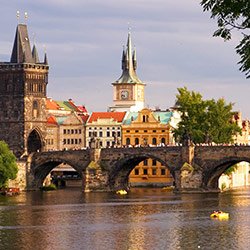Devices and Optic Transmission Media
Engineering & Social Sciences Program
Madrid, Spain
Dates: 1/16/26 - 5/30/26

Devices and Optic Transmission Media
OVERVIEW
CEA CAPA Partner Institution: Universidad Carlos III de Madrid
Location: Madrid, Spain
Primary Subject Area: Computer Engineering
Instruction in: English
Course Code: 13853
Transcript Source: Partner Institution
Course Details: Level 300
Recommended Semester Credits: 3
Contact Hours: 42
Prerequisites: Electronic Components and Circuits, Electromagnetic Fields
DESCRIPTION
THEORY:
- M0: Introduction to optical communications
- General structure of a communication system.
- Advantages and disadvantages of optical fibres.
- Light propagation in a medium.
- Physical structure of optical fibres
- Introduction to the electromagnetic waves. Regions of the eelectromagnetic spectrum.
M1: Optical sources: LED and laser
- 1.1. Introduction.
- 1.2. Types of emitters: LEDs y LASER.
- 1.3: Operation principle of emitters based on semiconductors.
- 1.4: LED. Eficiencies. Electrical & optical characteristics
- 1.5: LASER. Eficiencies. Electrical & optical characteristics
M2: Propagation, attenuation, dispersion in optical fibers
- 2.1. Introduction: Physical structure, operation principle.
- 2.2. Propagation, Singlemode/Multimode character.
- 2.3: Attenuation, transmission windows.
- 2.4: Dispersion: modal, chromatic, PMD. Bandwidth and distance limitation.
M3: Optical detectors
- 3.1. Introduction: Symbol y characteristics of photodiodes.
- 3.2. Signal conditioning circuits.
- 3.3: Structure and operation principle.
- 3.4: Types of optical detectors.
- 3.5: Noise considerations in optical detectors.
M4: Passive optical components and optical amplifiers
- 4.1. Modulators.
- 4.2. Couplers.
- 4.3: Splitters, isolators, circulators y filters.
- 4.4: Multiplexers, demultiplexers, intervalers. OADMs.
- 4.5: Optical amplifiers.
- 4.6: Optical switches.
M5: Optical transmission
- 5.1. Elements of an optical communication link.
- 5.2. Power balance.
- 5.3: Time balance. Bandwidth
M6: Multiplexing techniques and devices
- 6.1. Multiplexing techniques: TDM, FDM, CDM
- 6.2. Optical Time Division Multiplexing: SONET/SDH
- 5.3: Wavelength Division Multiplexing: CWDM y DWDM
LABORATORY:
- P1: Characterization of a LED. Attenuation and numerical aperture measurement.
- P2: Passive optical components characterization.
- P3: Characterization of a POF based optical communication link.
- M0: Introduction to optical communications
- General structure of a communication system.
- Advantages and disadvantages of optical fibres.
- Light propagation in a medium.
- Physical structure of optical fibres
- Introduction to the electromagnetic waves. Regions of the eelectromagnetic spectrum.
M1: Optical sources: LED and laser
- 1.1. Introduction.
- 1.2. Types of emitters: LEDs y LASER.
- 1.3: Operation principle of emitters based on semiconductors.
- 1.4: LED. Eficiencies. Electrical & optical characteristics
- 1.5: LASER. Eficiencies. Electrical & optical characteristics
M2: Propagation, attenuation, dispersion in optical fibers
- 2.1. Introduction: Physical structure, operation principle.
- 2.2. Propagation, Singlemode/Multimode character.
- 2.3: Attenuation, transmission windows.
- 2.4: Dispersion: modal, chromatic, PMD. Bandwidth and distance limitation.
M3: Optical detectors
- 3.1. Introduction: Symbol y characteristics of photodiodes.
- 3.2. Signal conditioning circuits.
- 3.3: Structure and operation principle.
- 3.4: Types of optical detectors.
- 3.5: Noise considerations in optical detectors.
M4: Passive optical components and optical amplifiers
- 4.1. Modulators.
- 4.2. Couplers.
- 4.3: Splitters, isolators, circulators y filters.
- 4.4: Multiplexers, demultiplexers, intervalers. OADMs.
- 4.5: Optical amplifiers.
- 4.6: Optical switches.
M5: Optical transmission
- 5.1. Elements of an optical communication link.
- 5.2. Power balance.
- 5.3: Time balance. Bandwidth
M6: Multiplexing techniques and devices
- 6.1. Multiplexing techniques: TDM, FDM, CDM
- 6.2. Optical Time Division Multiplexing: SONET/SDH
- 5.3: Wavelength Division Multiplexing: CWDM y DWDM
LABORATORY:
- P1: Characterization of a LED. Attenuation and numerical aperture measurement.
- P2: Passive optical components characterization.
- P3: Characterization of a POF based optical communication link.










